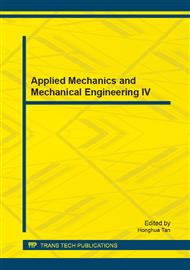[1]
Strom, A. L. and Korup, O. Extremely large rockslides and rock avalanches in the Tien Shan mountains, Kyrgyzstan [J]. Landslides, 2006, 3(2): 125-136.
DOI: 10.1007/s10346-005-0027-7
Google Scholar
[2]
Qiang XU, Runqiu HUANG, Yueping YIN, et al. The JIWEISHAN landslide of June 5, 2009 in Wulong Chongqing: Characteristics and Failure Mechanism[J]. Journal of Engineering Geology2009, 17(4): 433-444.
Google Scholar
[3]
Yong-xing ZHANG, Li LU, ZHANG Si-ping, et al. Development and Failure Principle of Differential Weathering Overhanging Rock [J]. Journal of Chongqing Jianzhu University, 2010, 32(2): 1-6.
Google Scholar
[4]
Frayssines, M. and Hantz, D. Modelling and back-analysing failures in steep limestone cliffs [J]. International Journal of Rock Mechanics and Mining Sciences, 2009, 46(7): 1115-1123.
DOI: 10.1016/j.ijrmms.2009.06.003
Google Scholar
[5]
Hong-kai CHEN, Hong-mei TANG, Si-qiao YE. Damage model of control fissure in perilous rock [J]. Applied Mathematics and Mechanics, 2006, 27(7): 967-974.
DOI: 10.1007/s10483-006-0713-y
Google Scholar
[6]
CHEN Hong-kai, TANG Hong-mei. Method to calculate fatigue fracture life of control fissure in perilous rock [J]. Applied Mathematics and Mechanics, 2007, 28(5): 643-649.
DOI: 10.1007/s10483-007-0509-1
Google Scholar
[7]
CHEN Hong-kai, XIAN Xue-fu, TANG Hong-mei. Stability Analysis Method for Perilous Rock by Fracture Mechanics [J]. Journal of Chongqing University, 2009, 32(4): 434-437.
Google Scholar
[8]
TANG Hong-mei, WANG Zhi, XIAN Xue-fu, et al. Violent- slide rock avalanche and excitation effect of perilous rock [J]. Journal of Chongqing University, 2011, 34(10): 39-45.
Google Scholar
[9]
Tang Hongmei , Wang Zhi, Chen Hongkai, XIAN Xuefu. Contribution ratio of excitation action triggered by collapse of perilous rock to stability of perilous rock[J]. Journal of Vibration and Shock , 2012, 31(20): 32-37.
DOI: 10.4028/www.scientific.net/amm.368-370.1633
Google Scholar
[10]
Fan Liuming, Li Ning. Transmission model of weak intercalation and its vibration isolation properties[J]. Chinese Journal of Rock Mechanics and Engineering, 2005, 24(14): 2456-2462.
Google Scholar
[11]
Ju Yang, Yang YongMing, Mao YanZhe, Liu HongBin, Wang HuiJie. Laboratory investigation on mechanisms of stress wave propagations in porous media[J]. Sci China Ser E-Tech Sci, 2009, 25(5): 1374-1389.
DOI: 10.1007/s11431-009-0128-y
Google Scholar
[12]
Yang Lin. Discussion on damage effect on surrounding rock mass in tunneling blasting[J]. Blasting, 2003, 20(s1): 19-23.
Google Scholar
[13]
Grady D E, Kipp M L. Continuum modeling of explosive fracture in oil shale[J]. Rock Mech Sci&Geomech, 1987, 17: 147-157.
Google Scholar
[14]
Yu Shouwen, Feng Xiqiao. Damage mechanics [M]. Beijing, Tsinghua University Press, (1997).
Google Scholar


